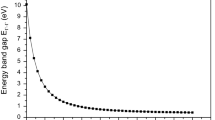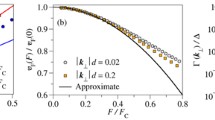Abstract
The conditions under which the band gaps of free standing and embedded semiconductor quantum dots are direct or indirect are discussed. Semiconductor quantum dots are classified into three categories; (i) free standing dots, (ii) dots embedded in a direct gap matrix, and (iii) dots embedded in an indirect gap matrix. For each category, qualitative predictions are first discussed, followed by the results of both recent experiments and state of the art pseudopotential calculations. We show that:
-
Free standing dots of InP, InAs, and CdSe will remain direct for all sizes, while dots made of GaAs and InSb will turn indirect below a critical size.
-
Dots embedded within a direct gap matrix material will either stay direct (InAs/GaAs at zero pressure) or will become indirect at a critical size (InSb/InP).
-
Dots embedded within an indirect gap matrix material will exhibit a transition to indirect gap for sufficiently small dots (GaAs/AlAs and InP/GaP quantum well) or will be always indirect (InP/GaP dots, InAs/GaAs above 43 k bar pressure and GeSi/Si dots).
In indirect nanostructures, charge separation can occur with electrons and holes localized on different materials (flat InP/GaP quantum well) or with electrons and holes localized in different layers of the same material (concentric cylindrical GaAs/AlAs layers).
Similar content being viewed by others
References
N. Stranski and L. Krastanow, Math.-Naturwiss Kl. Abt. IIb 146, 797 (1938).
N. Carlsson et al., Appl. Phys. Lett. 66, 3093 (1994).
K. Schmidt, G. Medeiros-Ribeiro, M. Oestreich and P. Petroff, Phys. Rev. B 54, 11346 (1996).
G. Solomon, J. Trezza, A. Marshall and J. Harris, Phys. Rev. Lett. 76, 952 (1996).
J. Prieto, G. Armelles, T. Utzmeier, F. Briones, F.C. Ferrer, F. Peiro, A. Cornet and J.R. Morante, Phys. Rev. Lett. 80, 1094 (1998).
M. Yang, J. Sturm J. Prevost, Phys. Rev. B. 56 1973 (1997).
M. Reed, Phys. Rev. lett. 60, 5353 (1988).
R. Leon, C. Lobo, T.P. Chin, J.M. Woodall, S. Fofard, S. Ruvimov, Z. Liliental-Weber and M.A. Steven-Kalceff, Appl. Phys. Lett. 72, 1356 (1998).
B. Junno, T. Junno, M. Miller and L. Samuelson, Appl. Phys. Lett 72, 954 (1998).
O. Micic, C. Curtis, K. Jones, J. Sprague and A. Nozik, J. Phys. Chem. 98, 4966 (1994).
S. Empedocles, D. Norris and M. Bawendi, Phys. Rev. Lett. 77, 3873 (1996).
A. Guzelian, U. Banin, A. Kadavanich, X. Peng and A. Alivisatos, Appl. Phys. Lett. 69, 1432 (1996).
A. Colvin, V.L. Alivisatos and Alivisatos and J. Tobin, Phys. Rev. Lett. 66, 2786 (1991).
Landolt and Börnstein, Numerical Data and Functional Relationships in Science and Technology, Vol. 22, Subvol. a (Berlin: Springer-Verlag, 1997).
A. Williamson, J. Kim, L.-W. Wang, S.-H. Wei and A. Zunger, unpublished results.
C. Pryor, J. Kim, L.-W. Wang, A. Williamson and A. Zunger, J. Appl. Phys. 83, 2548 (1998).
L.-W. Wang and A. Zunger, Phys. Rev. B, 51, 17398 (1995).
L.-W. Wang and A. Zunger, J. Chem. Phys. 100, 2394 (1994).
L.W. Wang and A. Zunger, Semiconductor Nanoclusters (Amsterdam: Elsevier Science, 1996).
A. Franceschetti and A. Zunger, Appl. Phys. Lett. 68, 3455 (1996).
A. Franceschetti and A. Zunger, J. Chem. Phys. 104, 5572 (1996).
H. Fu and A. Zunger, Phys. Rev. B 55, 1642 (1997).
H. Fu and A. Zunger, Phys. Rev. B 56, 1496 (1997).
H. Fu and A. Zunger, Phys. Rev. B 57, R15067 (1998).
H. Fu, L.-W. Wang and A. Zunger, Phys. Rev. B 57, 9971 (1998).
H. Fu and A. Zunger, Phys. Rev. Lett. 80, 5397 (1998).
A. Williamson and A. Zunger, Phys. Rev. B Code: BY6599 (1998).
L.-W. Wang and A. Zunger, J. Phys. Chem. 102, 6449 (1998).
L.-W. Wang and A. Zunger, Phys. Rev B 53, 9579 (1996).
U. Banin et al., J. Chem. Phys. (in press) (1998).
D. Bertram, O. Micic and A.Nozik, Phys. Rev. B 57 R4265 (1998).
S. Tolbert, A. Herhold, L. Brus and A. Alivisatos, Phys. Rev. Lett. 76, 4384 (1996).
A. Williamson and A. Zunger, Phys. Rev. B 48, 6724 (1998).
J. Kim, L.-W. Wang and A. Zunger, Phys. Rev. B 57, R9408 (1998).
A. Zunger, MRS Bulletin 23, 35 (1998).
G. Griffiths, K. Mohammed, S. Subbanna, H. Kroemer and J. Merz, Appl. Phys. Lett. 43, 1059 (1983).
J. Eshelby, J. Appl. Phys. 25, 255 (1954).
A. Franceschetti and A. Zunger, Phys. Rev. B 52, 14664 (1995).
J. Kim, L.-W. Wang and Z. Zunger, Phys. Rev. B 56, R15541 (1997).
A. Franceschetti, S.-H. Wei and A. Zunger, Phys. Rev. B Rapid Commun. 50, 8094 (1994).
S.-H. Wei and H. Krakauer, Phys. Rev. Lett. 55, 1200 (1985).
P. Keating, Phys. Rev. 145, 637 (1966).
C. Ulrich et al., Phys. Rev. B 52, 12212 (1995).
T. Okuno et al., Phys. Rev. B 57, 1386 (1998).
M. Pistol, N. Carlsson, W. Persson, C. Seifert and Seifert and L. Samuelson, Appl. Phys. Lett 67, 1438 (1995).
P. Castrillo et al., Appl. Phys. Lett 67, 1905 (1995).
A. Williamson, A. Zunger and A. Canning, Phys. Rev. B 57, R4253 (1997).
L.-W. Wang and A. Zunger, Phys. Rev B 56 (1997).
G. Li, A. Goni, K. Syassen, O. Brandt and K. Ploog, Phys. Rev. B 50, 18420 (1994).
I. Itskevich et al., Phys. Rev. B 54, 16401 (1996).
Author information
Authors and Affiliations
Rights and permissions
About this article
Cite this article
Williamson, A.J., Franceschetti, A., Fu, H. et al. Indirect band gaps in quantum dots made from direct-gap bulk materials. J. Electron. Mater. 28, 414–425 (1999). https://doi.org/10.1007/s11664-999-0089-8
Received:
Accepted:
Issue Date:
DOI: https://doi.org/10.1007/s11664-999-0089-8




